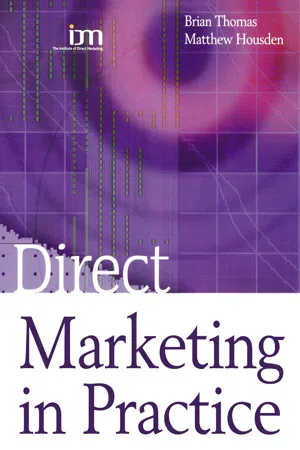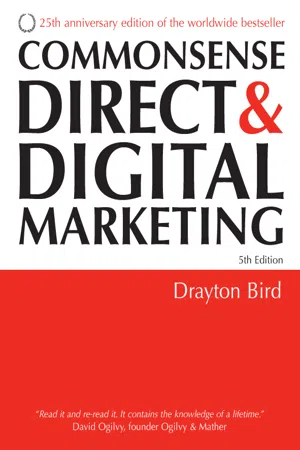Marketing
Direct Marketing
Direct marketing is a promotional strategy where businesses communicate directly with consumers to promote products or services. This approach often involves personalized communication through various channels such as email, direct mail, telemarketing, and targeted online advertising. The goal of direct marketing is to generate a direct response from the consumer, such as making a purchase or requesting more information.
Written by Perlego with AI-assistance
Related key terms
1 of 5
12 Key excerpts on "Direct Marketing"
- eBook - ePub
- Paul Reynolds, Geoff Lancaster(Authors)
- 2005(Publication Date)
- Routledge(Publisher)
Direct Marketing is broadly defined as any direct communication to a consumer or business recipient that is designed to generate a response in the form of a direct order, a request for further information (lead generation), or a visit to a store or other place of business for the purchase of a specific product or service (traffic generation). The emphasis is on Direct Marketing communication. A leading trade magazine, Direct Marketing, goes further and defines Direct Marketing as a process that is:‘An interactive system of marketing that uses one or more advertising media to affect a measurable response and/or transaction at any location, with this activity stored on a database.’Dibb and Simkin (2001, p. 545) defines Direct Marketing as:Fill (2002, p. 667) defines Direct Marketing:‘a decision by a company’s marketers to select a marketing channel that avoids dependence on marketing channel intermediaries, and to focus marketing communications activity on promotional mix ingredients that contact directly targeted customers.’‘Direct Marketing is a strategy used to create a personal and intermediary free dialogue with customers. This should be a measurable activity and it is very often media based, with a view to creating and sustaining a mutually rewarding relationship.’The goal is to provide the customer with information relative to their needs and interests. A profile on the direct and interactive marketing industry offers a useful way of looking at it as a cyclical process with six distinct phases: - eBook - ePub
- Geoffrey Lancaster, Lester Massingham(Authors)
- 2017(Publication Date)
- Routledge(Publisher)
Direct Marketing is broadly defined as any direct communication to a consumer or business recipient that is designed to generate a response in the form of a direct order, a request for further information (lead generation) or a visit to a store or other place of business for the purchase of a specific product or service (traffic generation). The emphasis is on Direct Marketing communication.Simkin et al. define Direct Marketing as: ‘A decision by a company’s marketers to select a marketing channel that avoids dependence on marketing channel intermediaries, and to focus marketing communications activity on promotional mix ingredients that contact directly targeted customers.’1 Pickton and Broderick describe the essence of Direct Marketing with emphasis on its use of customer information: ‘Direct Marketing is a marketing system based on individual customer records held on a database. These records are the basis for marketing analysis, planning, implementation of programmes, and control of this activity.’2 Fill defines Direct Marketing as a strategy: ‘A strategy used to create a personal and intermediary free dialogue with customers. This should be a measurable activity and it is very often media based, with a view to creating and sustaining a mutually rewarding relationship.’3Direct personal selling formed the bedrock of the Direct Marketing industry at the time of the establishment of the Direct Marketing Association (DMA) in the USA in 1917. The World Federation of Direct Selling Associations was founded in the USA in 1978 as a non-governmental voluntary organization representing the direct selling industry globally to support direct selling associations in areas of governance, education, communications, consumer protection and ethics in the marketplace.We have examined the nature of Direct Marketing and its role in the communications mix. The discussion that follows is not exhaustive, but it covers the main Direct Marketing tools and examines their application in different marketing situations. We start with direct mail and email, which has seen enormous growth as a Direct Marketing tool over the past 30 years. We then discuss the use of telephone or telemarketing, which has been used particularly in B2B marketing. Telemarketing and the use of direct mail were the two main pillars of the Direct Marketing industry when the DMA was established. Direct Marketing tools include developments in applying Internet technologies, including database marketing and techniques of data mining and data fusion that are central to the Direct Marketing revolution. We also examine direct response in television, newspaper and radio applications. - eBook - ePub
- Philip Kitchen, Patrick de Pelsmacker(Authors)
- 2004(Publication Date)
- Routledge(Publisher)
Due to technological changes, database technology, and changing buying habits, Direct Marketing, together with e-communications, has probably undergone the most drastic changes of all communication mix instruments. Direct mail, telemarketing, and direct response advertising have evolved from very traditional low profile and pushy techniques to a potentially highly sophisticated set of tools to build long-term relationships and engage in profitable interactions with customers. In the first section, Direct Marketing is defined, as well as its objectives, target groups, advantages and disadvantages, and its role in integrated marketing communications is highlighted. The factors and trends that have led to an increased use of these instruments are set out in the second section. An overview of the various media and techniques of Direct Marketing is found in section three. Section four discusses the effectiveness of Direct Marketing, and how it can be measured.The role of Direct Marketing in the IMC mix
Direct Marketing can be defined as:(Brassington and Pettitt, 2003, see also Duncan, 2002; Fill, 2002)An interactive system of personal and intermediary-free dialogue which uses one or more communications media to effect a measurable behavioural response at any location, forming a basis for creating and further developing an ongoing direct relationship between an organization and each of its customers individually.Contrary to instruments like advertising, sponsorship, and sales promotion, which mainly address mass audiences and are not capable of entering in a dialogue with individuals, Direct Marketing aims at creating one-to-one personalized and therefore persuasive interaction with (potential) customers. In that respect it is similar to personal selling. However, if carefully managed, Direct Marketing can substitute some of the tasks of the sales force much more cost-efficiently. Due to its direct-to-customer nature, expensive intermediary members of the trade channel are sidelined. The customer can be contacted by means of various media, tools, and techniques (direct response ads, direct mail, teleselling, etc.), but he or she does not necessarily need to go to a shop to respond. Information can be requested or products can be ordered at any location, by telephone, reply card, or via the Internet.Direct Marketing is essentially transaction-oriented - eBook - PDF
- Brian Thomas, Matthew Housden(Authors)
- 2017(Publication Date)
- Bloomsbury Business(Publisher)
SECTION ONE CHAPTER 1 DIRECT AND DIGITAL MARKETING TODAY WHAT DO WE MEAN BY DIRECT AND DIGITAL MARKETING? There are many definitions, but the following two are perhaps the most helpful: Direct Marketing is the process in which individual customers’ responses and transactions are recorded … and the data used to inform the targeting, execution and control of actions … that are designed to start, develop and prolong profitable customer relationships. Graeme McCorkell, Direct and Database Marketing 1997 This definition makes it clear that the primary job of Direct Marketing – as indeed of all marketing – is to convey a message , a message which is intended to provoke an action or response . Direct & digital marketing is the practice of building and harnessing customer data and insight to target, execute and control the creation and delivery of customer IN THIS CHAPTER We will introduce the discipline of direct and digital marketing and discuss the following topics: What do we mean by direct and digital marketing? Web 2.0 and the social media revolution Mobile and the rise of multi-screeners Firms that deal direct Multi-channel marketing Principles of direct and digital marketing (TICC) The continuing problem of attribution Direct Marketing and Pareto’s Principle Ten ways in which digital marketing is different Summary 2 DIRECT AND DIGITAL MARKETING IN PRACTICE value across all interactive channels to start and prolong profitable customer relationships. Derek Holder and Paul McCarthy 2011 The second definition, by Holder and McCarthy, is more up-to-date as it refers to creating customer value across all interactive channels , which is recognized today as the overriding purpose of a successful twenty-first century business. SO, WHAT IS MARKETING? A typical twentieth-century definition was: Marketing is the management process that identifies, anticipates and satisfies customer requirements profitably. - Robyn Blakeman(Author)
- 2013(Publication Date)
- SAGE Publications, Inc(Publisher)
10 Direct Marketing and Sales Promotion T his chapter defines the ways that Direct Marketing can be used to build a relationship with the target. Its various forms are dissected oneby-one to show how this customized media vehicle can reach the selected target with a message that reflects and embodies their lifestyle. Discussions also cover how sales promotions can be used as an enticement to further research a brand, visit a brick-and-mortar store, or increase brand awareness and brand value. Direct Marketing Makes Reaching the Target Personal As previously discussed, marketers and advertisers have typically used traditional advertising vehicles to launch or reposition a brand, build awareness, define image, and announce a sale. Unlike mass marketing’s generic approach to message delivery, a personalized, relationship-building tactic is possible with Direct Marketing, in order to further enhance the relationship between buyer and seller. These highly customized messages call the target by name and tie the sales message directly to the target’s interests and lifestyle. Because of this, the cost to reach the target is relatively expensive but extremely measurable. One of the most encompassing definitions of Direct Marketing comes from Daniel Cortes: “a promotion and communication strategy that allows you to target a specific market using different media in order to stimulate your customer’s behavior in a way that you can measure, track and analyze all the information involved in the process and store it on a database for future use” (Cortes, 2011, p. 1). Direct Marketing—also known as relationship marketing —is a great way to develop and maintain a relationship with the target over time. It ignores the middleman or retailer and allows the manufacturer to interact and sell directly to the targeted audience- eBook - ePub
- Matthew Housden, Brian Thomas(Authors)
- 2012(Publication Date)
- Routledge(Publisher)
Even in its current form, Direct Marketing has been around for a long time, but it has really been with us since marketing began. Hundreds of years ago, a manufacturer of, for example, clothing or fine tableware, would use one-to-one marketing methods, seeking out selected customers, identifying their precise needs, and developing specific products to satisfy those needs.Direct Marketing is a discipline, a subset of marketing, which permits us to carry out certain marketing tasks more efficiently. It does this by gathering, analysing and using information about individual customers and prospects. This information enables us to identify which of the people on our customer and prospect files are likely to be interested in a particular product, service or offer.After the first round of one-to-one marketing, came mass production, which, successfully it must be said, adopted the ‘this is what we make, now go and buy it’ approach. But today, as customers have become more affluent and more individualistic, they have also become more knowledgeable and more discerning, and the ‘broad brush’ approach does not work so well any more.One of the reasons for IBM’s change of fortunes in the early 1990s was Gerstner’s abandonment of its former policy, quoted by one of their senior executives as ‘We make, you take; we talk, you listen’. This policy would be commercial suicide today.Happily, today’s marketers have modern technology to help them deliver the more focused communications and service required whilst still dealing with a high volume of customers and prospects. One expert recently defined Direct Marketing as ‘Using tomorrow’s technology to deliver yesterday’s standards of service to today’s customers’. So what is Direct Marketing?Direct Marketing is a discipline, a subset of marketing, which permits us to carry out certain marketing tasks more efficiently. It does this by gathering, analysing and using information about individual customers and prospects. This information enables us to identify which of the people on our customer and prospect files are likely to be interested in a particular product, service or offer. - eBook - ePub
- Ross Brennan, Louise Canning, Raymond McDowell(Authors)
- 2020(Publication Date)
- SAGE Publications Ltd(Publisher)
Direct Marketing does this by providing a framework for three activities: analysis of individual customer information (e.g. communication and transaction behaviour), strategy formation, and implementation such that customers engage directly with the vendor through a variety of on- and offline channels and media (Tapp et al., 2014). Key features of Direct Marketing include: the absence of face-to-face contact; the use of on- and offline media for direct, one-to-one communication and transactions; and the facility to monitor and measure communication and transaction behaviour. Our discussion of Direct Marketing includes social media as well as more established forms such as mail and telemarketing, on the basis that they all offer scope for direct interaction, although communication via social media marketing is more suited to a ‘soft-sell’ approach, while mail and telemarketing might be more appropriate for sales-specific campaigns. Social Media In Chapter 7, we discussed the development of a company’s market presence, how this should contribute to signalling an organization’s expertise and credibility, and ways in which a company might be found by and remain visible to interested parties. Exposure to advertising campaigns or viewing marketing content generated from online searches might increase awareness and inform or educate an audience, but key to building positive associations with a business brand or supplier is customer engagement. Social media can contribute to this through the combined use of information-sharing sites such as YouTube, SlideShare, Flickr and Instagram and social networking sites on which community members can express or share an opinion (Schroeder, 2013) - eBook - ePub
Good Small Business Guide 2013, 7th Edition
How to Start and Grow Your Own Business
- Bloomsbury Publishing(Author)
- 2013(Publication Date)
For businesses of all sizes, Direct Marketing works most effectively when it is aimed at a precise audience that cannot be easily reached by any other medium. A campaign should be carefully planned in accordance with the target market and the product or service concerned. Short-term results can be measured accurately and directly by the level of response, so the effectiveness of a campaign can be assessed quickly. There are, however, many different factors that can affect the outcome, such as product price or the quality of the campaign material. As with any direct approach, it is essential to make it as easy as possible for customers to respond.FAQS
Is Direct Marketing the same as direct mail?
No. Direct Marketing (DM) is any marketing activity that depends on a direct and measurable response. Conventional advertising can be ‘direct’, as can telephone, fax, e-mail and, of course, the Internet. Direct mail is Direct Marketing communication sent by post, and therefore often has a poor reputation because of the amount of unsolicited mail that people regularly receive.Can Direct Marketing be used to sell products?
There are many situations in which you can use Direct Marketing to build direct sales. You may not have a salesforce or a retail network, so customers can only buy direct from you. If you want to sell to niche markets, or if your customers are widely spread or even global, Direct Marketing may be the only cost-effective way of reaching them. If you decide to sell direct, you must ensure that the products themselves are suitable for selling through Direct Marketing—that is, that they do not have to be demonstrated, or inspected by the customer.How does Direct Marketing build relationships with customers?
The stronger your relationship with your customers, the more opportunities you have to influence the future direction and success of your business. If your company depends on a few key customers for most of its business, you can use Direct Marketing to improve customer loyalty by building long-term relationships with them. You may also need to use it if your customers want to rationalise the number of suppliers, and you want to remain on the approved list. - eBook - ePub
- Ian Linton(Author)
- 2017(Publication Date)
- Routledge(Publisher)
By comparing Direct Marketing in relation to other advertising media, you can determine the most effective route for reaching new prospects. Direct Marketing also allows you to approach new prospects in a variety of different ways, using different creative approaches or varying the promotional offer. The training company planned a diverse Direct Marketing campaign which included the following elements:- special discounts were offered to customers who requested demonstrations within a certain timescale
- follow-up mailings to customers who had not responded within a certain timescale
- welcome mailings to prospects who responded.
Direct Marketing in an integrated programme
Direct Marketing can be used in a stand-alone role, as an alternative to broadcast media such as advertising but, in an integrated campaign, it must be used to strengthen the effectiveness of the campaign. It could be used in the following ways:- as a follow-up to the direct response advertising campaign. The advertisements provide information on warm prospects which can be used to form a database for future Direct Marketing programmes
- to make differentiated offers to prospects who respond to the advertising campaign
- to supplement the advertising campaign's coverage of different target markets. Direct Marketing can be used to reach sectors that cannot be reached efficiently by other media
- to reinforce the impact of the advertising campaign by selective follow-up.
Telemarketing
Telemarketing is the process of using the telephone to contact customers and prospects. Telemarketing can be used to supplement the advertising and Direct Marketing campaigns through inbound and outbound programmes.Outbound programmes
Outbound programmes are those in which the company takes the initiative. They can be used to handle a number of different tasks: - eBook - ePub
Shoot to Sell
Make Money Producing Special Interest Videos
- Rick Smith, Kim Miller(Authors)
- 2013(Publication Date)
- Routledge(Publisher)
The main form of DM that we’ve found very effective in our small business is email marketing. That’s such an important topic that we’re devoting the next chapter to it in this book. Email marketing is the foundation of our online marketing funnel.You’ve probably entered many similar marketing funnels when you traded your name and email for a free gift, free report, special video, or whatever. That action entered you in someone’s marketing funnel and you soon, if not immediately, began receiving email from them. You became a prospect.A common and annoying form of Direct Marketing is telemarketing. Those dinnertime calls asking, “How are you doing this evening?” are another way of asking for a direct response. I dislike them but they obviously work or people wouldn’t be spending the money to do them.Other DM tools include broadcast faxing (which is illegal and thankfully, disappearing), coupons, infomercials, inserts in your newspaper, stickers on newspapers and magazines, postcard packets like ValPak, voicemail marketing, pay-per-click advertising, and the granddaddy of them all—direct mail marketing. All of them are effective in the right markets when used well.The Importance of Tracking
At its core, DM is all about targeting the right prospects with the right offer at the right time and right price, providing a strong and clear “call to action,” and providing an easy way to respond. Finally, it’s very focused on tracking and measuring results in order to continually refine the targeting component.Direct mail marketing uses codes on each mailing piece to track response. Online marketing can track sales from specific landing pages and by using embedded code, called cookies for some mysterious reason, to track a sale.In my catalog marketing days we would add a code before the order number of every product in the catalog. This code would change with every catalog. The Winter 2005 code might be W05 and would be added before the real order number for every product in the catalog. Most customers didn’t know that wasn’t part of the order number so they would include it on the order form. Then the person entering the order would know that the order came from the Winter 2005 catalog and would make note of it. - eBook - PDF
- Thomas O'Guinn, Chris Allen, Angeline Close Scheinbaum, Richard Semenik(Authors)
- 2018(Publication Date)
- Cengage Learning EMEA(Publisher)
Internal lists are valuable for strengthening relationships with current customers, and external lists are useful in generating new customers. A marketing database is a natural extension of the internal list but includes information about individual customers and their specific preferences and purchasing patterns. A marketing database can be viewed as an exten-sion of an internal mailing list with additional information about individual preferences and behavioral patterns, al-lowing organizations to identify and focus efforts on their best customers. This database can help in recognizing and reinforcing preferred customers for building loyalty, as well as for cross-selling opportunities and for gaining insights about how to attract new customers. However, many consumers are uneasy about privacy issues related to marketing databases. 3. Describe the prominent media used by direct market-ers in delivering their messages to the consumer. Direct mail and telemarketing are commonly used in executing Direct Marketing programs, as well as low-cost alternatives such as email and text messages. Because the advertising done as part of Direct Marketing programs typ-ically requests an immediate response from the customer, it is known as direct response advertising. Conventional media such as television, newspapers, magazines, and ra-dio are also used for direct response by offering a toll-free number or a website to facilitate customer contact. 4. Explain the key role of Direct Marketing and personal selling in complementing other advertising activities. Personal selling is the use of one-to-one communication and persuasion for the purpose of selling; traditionally via face-to-face communications, now personal selling has emerged to include personal chats, video sessions, calls, and other ways to communicate in a more personal manner with a consumer as it relates to a sale or service. - eBook - ePub
- Drayton Bird(Author)
- 2007(Publication Date)
- Kogan Page(Publisher)
Now let us look at objectives. What are direct marketers normally trying to achieve? FIVE MAJOR OBJECTIVES OF DIRECT MARKETERS … Actions, not just feelings Although we’ve looked at many ways in which Direct Marketing can be applied, you can break down all the activities I know of into five simple categories. You can ask people to:- Buy through the post, over the phone, or off the TV set, either for cash or by quoting a credit card or account number. Here I include charity donations.
- Ask for catalogues, or literature, or information which may come through the post, on the telephone or in the hands of salesmen (with or without the consumer’s prior knowledge).
- Request a demonstration either in the home, at work, or even at the seller’s premises.
- Visit a retail establishment, a film show or exhibition – or even a political or community event.
- Take part in some action like joining a protest demonstration, or writing to an MP or some foreign power.
Notice that in all cases we are asking people to do something. Direct Marketing is asking for action, whereas advertising is usually trying to influence thoughts and feelings. A critical distinction.To reach your chosen objective, you can choose from a variety of routes. The possibilities and permutations are bewildering, but it is essential that you are aware of them all. A sale you could never make profitably in one step, for example, could be easily made if the product is broken down and sold in stages as a continuity product, or if the sale is made by asking for an enquiry and then following up repeatedly. Equally, a product you could not sell easily for cash might do very well if you offered it on free trial.
Index pages curate the most relevant extracts from our library of academic textbooks. They’ve been created using an in-house natural language model (NLM), each adding context and meaning to key research topics.











